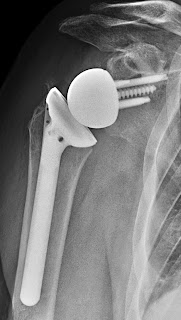The reverse total shoulder, like the anatomic total shoulder, achieves stability by concavity compression. The glenoid component manages the compressive force applied to it by a combination of compressive and tensile loading of the glenoid bone. As long as the net glenohumeral joint reaction force is contained within the humeral socket, the articulation is stable.


The ideal implant (1) enables a relatively anatomic reconstruction in contrast to those that result in distal displacement of the humerus with the associated increased risk of fracture of the acromion (shown below)
or neurologic injury from lengthening the arm; (2) preserves glenoid bone stock; (3) provides immediate glenoid fixation with a screw that engages the cortex of the subscapularis fossa compressing the baseplate against the prepared glenoid bone without having to wait for tissue ingrowth; (4) has enough lateral offset to prevent unwanted contact between the medial aspect of the humeral component and the glenoid without the need for bone graft interposed between the baseplate and the glenoid to achieve this offset; and (5) allows for fixation of a monoblock humeral stem with impaction grafting, avoiding the stress riser that would otherwise exist between the end of the cement or press fit stem tip and the often weak bone distal to that point (as shown below)

and obviating the risk of failure at the juncture between the metaphyseal and diaphyseal parts of the humeral implant (as shown below).

and obviating the risk of failure at the juncture between the metaphyseal and diaphyseal parts of the humeral implant (as shown below).
So this is the type of reverse prosthesis that we find most attractive.
Be sure to click on this link to the Shoulder Arthritis Book.
----
Use the "Search" box to the right to find other topics of interest to you.
You may be interested in some of our most visited web pages including:shoulder arthritis, total shoulder, ream and run, reverse total shoulder, CTA arthroplasty, and rotator cuff surgery as well as the 'ream and run essentials'
You may be interested in some of our most visited web pages including:shoulder arthritis, total shoulder, ream and run, reverse total shoulder, CTA arthroplasty, and rotator cuff surgery as well as the 'ream and run essentials'









